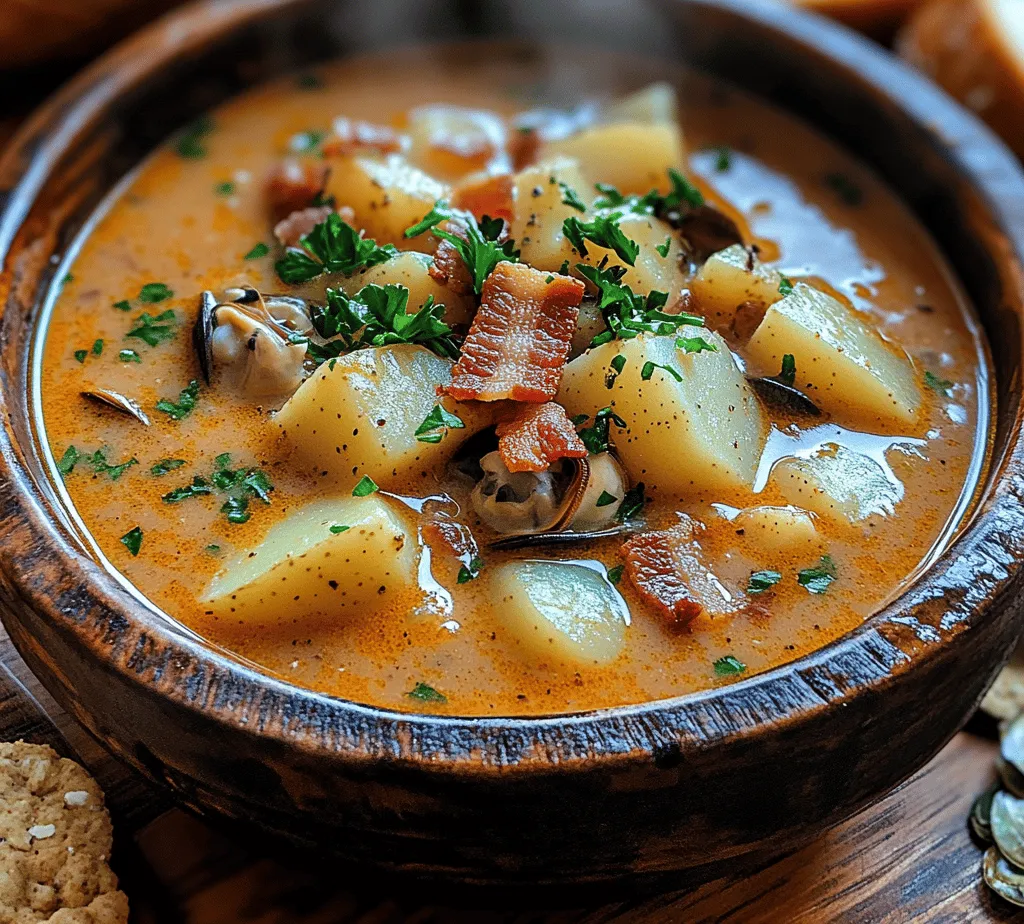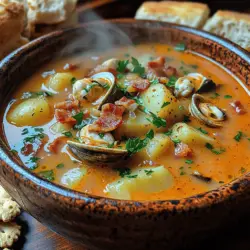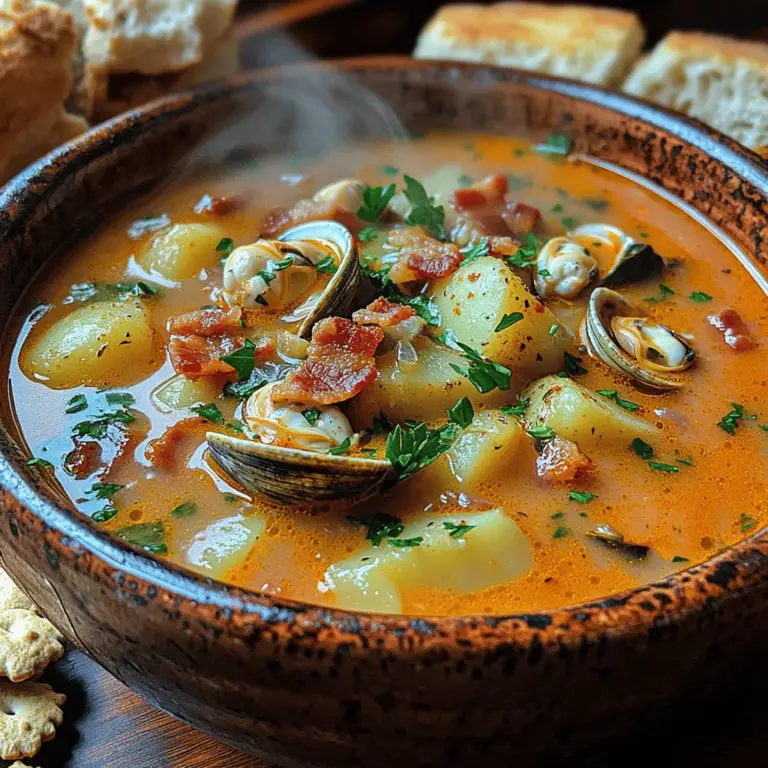Introduction
New England Clam Chowder is more than just a dish; it’s a beloved regional icon that embodies the rich culinary heritage of the Northeastern United States. This classic chowder is known for its creamy base, brimming with tender clams, and accented with smoky bacon. As the temperatures drop and the leaves begin to change, there’s nothing quite like a warm bowl of clam chowder to evoke a sense of comfort and nostalgia. Whether served at a family gathering, a cozy dinner party, or simply enjoyed on a chilly evening, this chowder is the perfect companion.
The magic of New England Clam Chowder lies in its harmonious balance of flavors and textures. The smokiness of crispy bacon melds beautifully with the briny sweetness of fresh clams, while the creamy broth envelops each ingredient, creating a dish that is both hearty and satisfying. With every spoonful, you are transported to the rugged shores of New England, where this chowder has a storied history and a special place in the hearts of many.
Understanding New England Clam Chowder
Definition and History
New England Clam Chowder is a creamy soup made primarily with clams, potatoes, onions, and bacon, traditionally thickened with milk or cream. Its origins can be traced back to the early 18th century when European settlers arrived in America and began to adapt their culinary traditions using local ingredients. The dish quickly became popular in coastal towns, where fresh clams were abundant.
Over the years, clam chowder has seen various adaptations, but New England Clam Chowder remains the most recognized version. It gained prominence in the 1930s when the first canned clam chowder was produced, making it more accessible to the masses. Today, it is a staple in seafood restaurants and diners across the region, often served with oyster crackers or a slice of crusty bread.
Key Characteristics
What sets New England Clam Chowder apart from other chowder varieties, such as Manhattan Clam Chowder, is its creamy texture and rich flavor profile. The use of dairy gives it a luxurious mouthfeel, while the fresh clams contribute a briny depth that is unmistakable. The inclusion of aromatic vegetables like onions and celery adds a layer of flavor, while potatoes provide substance, making this chowder a hearty meal in itself.
Fresh clams are the star of this dish, and their quality can significantly impact the overall taste. While canned clams can be used in a pinch, nothing compares to the flavor and texture of freshly harvested clams. Additionally, the use of local ingredients, such as fresh herbs, elevates the chowder and pays homage to its New England roots.
Ingredients Breakdown
Essential Ingredients
When it comes to making a truly memorable New England Clam Chowder, selecting the right ingredients is essential. Here’s a breakdown of each key ingredient and its role in the chowder:
– Bacon: The foundation of flavor in this chowder, bacon adds a smoky depth that enhances the overall taste. It infuses the broth with richness and provides a satisfying crunch when cooked to perfection.
– Clams: The hero of the dish, clams provide a briny sweetness that is the hallmark of clam chowder. You can choose between fresh clams, such as cherrystone or littleneck, or opt for canned clams for convenience.
– Aromatics: Onions and celery form the aromatic base of the chowder. They contribute essential flavors that complement the brininess of the clams and provide a savory foundation for the soup.
– Potatoes: Diced potatoes add heartiness and texture to the chowder. They absorb flavors from the broth and become tender during cooking, making each spoonful satisfying.
– Dairy: Heavy cream and milk create the signature creamy texture of New England Clam Chowder. The combination of both dairy products enhances the richness without overpowering the other flavors.
Optional Ingredients
While the essential ingredients create a classic clam chowder, there are several optional ingredients you can consider to customize your dish:
– Vegetables: Carrots or leeks can be added for additional sweetness and flavor. Just be mindful of the balance of flavors to maintain the chowder’s integrity.
– Spices: A pinch of thyme or bay leaf can enhance the aromatic profile, adding depth without overshadowing the primary flavors.
– Fresh Herbs: Chopped parsley or chives sprinkled on top can provide a fresh finish that brightens the dish.
Importance of Quality Ingredients
When it comes to cooking, the quality of your ingredients is paramount, especially in a dish like New England Clam Chowder. Fresh, high-quality clams are essential for achieving the best flavor. If you have access to a local seafood market, consider purchasing clams directly from the source, as they will be the freshest option available.
Similarly, using good-quality bacon will ensure that your chowder has a rich, smoky flavor. Avoid processed or pre-packaged bacon, as they often lack the depth that a well-cured bacon can provide. When it comes to dairy, opt for whole milk and heavy cream rather than low-fat alternatives to achieve that luxurious creaminess.
Step-by-Step Cooking Instructions
Cooking the Bacon
To begin your journey to a delicious bowl of New England Clam Chowder, start by cooking the bacon. This step is crucial, as the rendered fat from the bacon will serve as the base for your chowder, infusing it with flavor. Here’s how to achieve that perfect crispiness:
1. Choose the Right Pan: Use a large, heavy-bottomed pot or Dutch oven to cook the bacon. This will distribute heat evenly and prevent sticking.
2. Cut into Chunks: For a rustic feel, cut the bacon into 1-inch pieces. This will allow the bacon to crisp up nicely while providing hearty bites throughout the chowder.
3. Cook Over Medium Heat: Place the pot over medium heat and add the bacon pieces. Allow them to cook slowly, stirring occasionally, until they are golden brown and crispy. This process usually takes about 8-10 minutes.
4. Drain Excess Fat: Once the bacon is cooked, use a slotted spoon to transfer it to a plate lined with paper towels to drain excess fat. Leave about 2 tablespoons of the rendered fat in the pot, as this will add flavor to the chowder.
5. Keep the Bacon Warm: Set the cooked bacon aside while you prepare the remaining ingredients. It will add a wonderful crunch and flavor to the finished chowder when added back in.
By following these steps, you’ll achieve perfectly crispy bacon that will elevate your New England Clam Chowder to new heights. In the next part of this article, we will delve into the remaining cooking instructions, guiding you through the process of bringing this hearty dish to life. Stay tuned to discover how to combine the ingredients and create a chowder that is sure to impress family and friends alike.

Sautéing Aromatics
The first step in crafting a bowl of Hearty New England Clam Chowder is to sauté the aromatics, which form the flavor foundation of the dish. Begin by heating a generous amount of butter in a large Dutch oven over medium heat. Once the butter has melted and begins to bubble slightly, add finely chopped onions, celery, and garlic. Sauté these ingredients for about 5-7 minutes, or until they turn translucent and fragrant.
This step is crucial for flavor development. The gentle heat helps to release the natural sweetness of the onions and the earthiness of the garlic, creating a robust flavor profile that will carry throughout the chowder. Make sure to stir frequently to prevent any browning, which can introduce bitterness. A well-executed sauté will set the stage for a rich, savory base that complements the briny clam flavor.
Incorporating Potatoes and Clams
After your aromatics are beautifully softened, it’s time to incorporate the star ingredients: potatoes and clams. For the potatoes, use Yukon Gold or Russet, as they hold their shape well during cooking. Dice them into uniform cubes to ensure even cooking. Add the potatoes to the pot along with the sautéed aromatics, stirring to combine.
Next, introduce the chopped clams to the mix. If you’re using fresh clams, ensure they’ve been cleaned and scrubbed thoroughly. If using canned clams, drain them and reserve the juice for later. The balance of flavors and textures is essential in this step; the potatoes will add creaminess, while the clams will provide a delightful brininess that is quintessential to clam chowder.
Stir everything together, making sure the ingredients are well distributed. The heat should still be at medium, allowing the potatoes to begin to soften without falling apart.
Creating the Base with Flour
Now, it’s time to create the chowder’s creamy base. Sprinkle in about a quarter cup of all-purpose flour over your sautéed vegetables, clams, and potatoes. This step is vital for thickening the chowder and achieving that signature velvety texture. To avoid lumps, it’s important to whisk the flour into the mixture vigorously.
Gradually pour in some of the reserved clam juice, stirring constantly. This will help to evenly distribute the flour and prevent clumping. If you find lumps forming, don’t panic—just continue to stir and break them apart. Once the flour is fully incorporated and you have a smooth mixture, you can slowly add in your broth (preferably fish or chicken broth) while keeping the heat on medium.
Simmering to Perfection
With your base now established, it’s time for the chowder to simmer. Bring the mixture to a gentle boil, then reduce the heat to low and let it simmer for about 20-30 minutes. This step is important for flavor infusion and ensuring the potatoes are tender without disintegrating.
As the chowder simmers, the flavors will meld beautifully, and the potatoes will become creamy. Stir occasionally to prevent anything from sticking to the bottom of the pot. If you notice that the chowder is getting too thick, feel free to add more broth or water to achieve your desired consistency.
Adding Dairy
Once your chowder has simmered to perfection, it’s time to add the dairy components. For a traditional New England clam chowder, heavy cream is the go-to choice. Pour in about a cup of heavy cream, stirring gently to combine.
To maintain a smooth texture and avoid curdling, it’s best to add the cream off the heat or at a low temperature. If you prefer a lighter chowder, half-and-half or whole milk can be substituted, but keep in mind this will alter the richness. For a unique twist, you can also stir in a tablespoon of cream cheese for added creaminess.
Final Touches and Garnishing
After adding the dairy, give your chowder a taste and adjust the seasoning with salt and freshly cracked black pepper as needed. For an extra burst of freshness, consider adding a splash of Worcestershire sauce or a pinch of cayenne pepper for a subtle kick.
When ready to serve, ladle the chowder into bowls and garnish with minced fresh herbs, such as parsley or chives. A sprinkle of freshly cracked pepper adds an appealing touch too. For presentation, serve the chowder in rustic bread bowls for a delightful dining experience.
Serving Suggestions
Ideal Accompaniments
Hearty New England Clam Chowder is best enjoyed with a side of crusty bread or oyster crackers. A thick slice of sourdough or a warm baguette is perfect for dipping, soaking up the creamy broth. Oyster crackers add a delightful crunch and complement the chowder’s richness.
Suggested Pairings
For beverage pairings, consider a chilled glass of white wine, such as a crisp Sauvignon Blanc or a buttery Chardonnay, both of which enhance the seafood notes in the chowder. If you prefer beer, a light lager or pale ale would pair wonderfully, balancing the richness of the chowder with refreshing notes.
Nutritional Information
Clam chowder is not only comforting but also packed with nutritional benefits. Clams are an excellent source of lean protein, iron, and vitamin B12. The potatoes provide dietary fiber and potassium, while the cream contributes calcium and fat.
A typical serving of New England clam chowder contains around 350-400 calories, depending on the ingredients used. It typically offers about 15-20 grams of protein, 20-25 grams of fat, and 30-40 grams of carbohydrates. For a lighter version, consider reducing the amount of cream or using alternatives such as milk or a plant-based cream.
Cultural Significance of Clam Chowder
Clam chowder holds a cherished place in New England culture and cuisine. Its origins date back to the early colonial days, where it was made by fishermen and settlers using local ingredients. Today, it’s a staple dish in many coastal towns, often featured in seafood festivals and family gatherings.
The chowder is particularly popular during colder months, providing warmth and comfort on chilly days. It is a classic dish often served on holidays and special occasions, embodying the spirit of New England hospitality.
Variations of clam chowder can also be found across the United States, such as the tomato-based Manhattan clam chowder. However, the creamy, rich texture of the New England style remains the most beloved.
Conclusion
Hearty New England Clam Chowder is more than just a dish; it’s a comforting experience that brings warmth to the heart and home. The process of making this classic chowder allows you to indulge in the rich flavors of the sea while creating lasting memories with family and friends.
By preparing this chowder at home, you not only savor its delightful taste but also celebrate a cherished culinary tradition. So gather your ingredients, follow these steps, and enjoy the joy of crafting a bowl of clam chowder that’s sure to become a favorite in your kitchen.

